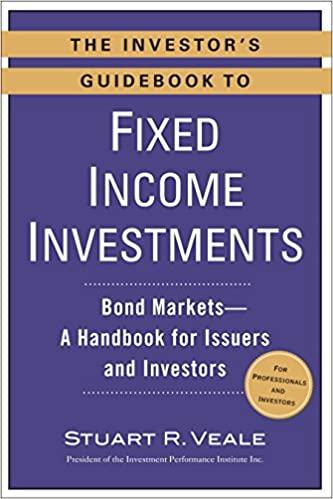Question
Minicase Ch.15 Fundamentals of Corporate Finance 7th Edition Within 3 years Mutt.Com was generating revenues of 3.4$ million a year and despite raching up sizable
Minicase Ch.15 Fundamentals of Corporate Finance 7th Edition
Within 3 years Mutt.Com was generating revenues of 3.4$ million a year and despite raching up sizable losses, was regarded by investors as one of the hottest new e-commerce businesses. The news that the company was preparing to go public therefore generated considerale excitement. The company's entire equity capital of 1.5 million shares was owned by the two founders and Ms. Slober. The initial public offering involved the sale of 500,000 shares by the three existing shareholders, together withthe sale of a further 750,000 shares by the company in order to provide funds for expansion.
The compnay estimated that the issue would involce legal fees, auditing, printing, and other expenses of 1.3$ million, which would be shared proportionately between the selling shareholders and the company. In addition, the company agreed to pay the underwriters a spread of $1.25 per share (this cost also would be shared).
The roadshow had confirmed the high level of interest in the issue, and idications from investors suggested that the entire issue could be sold at a price of $24 a share. THe underwriters, however, cautioned about being too greedy on price. The pointed out that indications from investors were not the same as firm orders. Also they argued, it was much more important to have a successful issue than to have a group of disgruntled shareholders. They therefore suggeste an issue of price of $18 a share.
That evening Mutt.Com's financial manger decided to run through some calculations. First, she worked out the net receipts to the company and the existing shareholders assuming that the stock was sold for $18 a share. Next, she looked at the various costs of the IPO and tried to judge how they stacked up against the typical costs for similiar IPOs. That brought her up against the question of underpricing. When she had raised the matter with the underwriters that morning, they had dismissed the notion that the intitial day's return on an IPO should be considered part of the issue costs. One of the members of the underwriting team had asked: "The underwriters want to see a high return and a high stock price. Would Mutt.Com prefer a low stock price? Would that make the issue less costly?" Mutt.Com's financial manager was not convinced but felt that she should have a good answer. She wondered whether under pricing was only a problem because the existing shareholders were selling part of their holdings. Perhaps the issue price would not matter if they had not planned to sell.
After reading that background I need help with this:
Read the minicase at the end of chapter 15 page 433. Suppose the underwriter purchased the stocks from the issuer at $15 per share and sold to public at $18. What would have been the total cost of underwriting assuming other expense, legal, auditing, and distribution costs was $1.3 million? What would have been total cost as a percentage the market value if investors valued the stock at $20 per share?
Step by Step Solution
There are 3 Steps involved in it
Step: 1

Get Instant Access to Expert-Tailored Solutions
See step-by-step solutions with expert insights and AI powered tools for academic success
Step: 2

Step: 3

Ace Your Homework with AI
Get the answers you need in no time with our AI-driven, step-by-step assistance
Get Started


